Written by Hilary Holmes, Open University Staff Tutor in the School of Mathematics and Statistics.
One of the great things about working for the OU is that occasionally we are able to share lots of wonderful mathematical ideas with hundreds of people at national events, such as the Big Bang Fair in Birmingham. So when it was announced that the STEM faculty was having a stand at the New Scientist Live exhibition in London and that the theme was paper engineering, this was an opportunity not to be missed! The challenge was to come up with some paper maths that was unusual, fun to play with, but that was also fairly easy and quick to make. We already use some paper folding activities in our introductory maths course (MU123) to help with geometrical ideas and to illustrate how these ideas are used from space exploration to medicine, but something new was needed here!
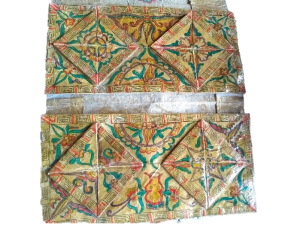
A Zhen Xian Bao at the textiles fair
I had recently seen some amazing Chinese needle thread booklets (Zhen Xian Bao) at an international textiles fair. These beautifully decorated booklets consist of layers of interconnected collapsible paper boxes, often enclosed in an indigo cloth cover. Originally these booklets were made by Chinese Minority people, mostly in the southern Chinese provinces of Guizhou and Yunnan. They were used to store threads, tools and patterns for their richly embroidered clothes. Have a look at this short (40 s) clip to see both an original and a modern booklet in action.
https://www.youtube.com/watch?v=8roBJJbpWAk
However, at the beginning of this century, the use of the booklets appeared to be dying out. Fortunately in 2012 after a lot of research, Ruth Smith and Gina Corrigan published their book `A Little Known Chinese Folk Art – Zhen Xian Bao’. This research has helped to revive the craft and it is now fairly easy to find online and other courses on how to construct a needle thread booklet.
A Zhen Xian Bao, full of mathematical ideas and puzzles instead of needles and threads, seemed perfect for the New Scientist exhibition!
The first step was to try and make a booklet. As you saw in the video, there are basically two types of collapsible boxes to construct:
- the top layer boxes, which are either ‘twist boxes’’ or star boxes
- rectangular boxes for the layers below. These have flaps which enable the layers of boxes to be connected together.
There are some instructions (about 30 mins) on how to create a flat thread booklet with star boxes here: https://www.youtube.com/watch?v=9NzHjdjFXOM .
There are lots of mathematical ideas to explore in a thread booklet!
These range from simple counting and recognising patterns in the construction of the book, to describing these properties algebraically and describing the design of the top layer geometrically.
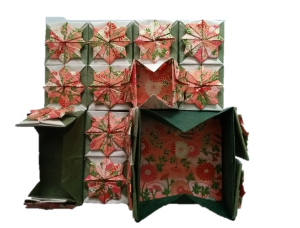
Open boxes on the top three layers
For example, if you try to make a booklet, the first step is to decide how many layers to have and then how many boxes will be needed. Working upwards from the base, each square box has two rectangular boxes in the layer above it then in the next layer each rectangular box has two square boxes.. In other words, starting from the base, the number of boxes double on each layer: 1, 2, 4, 8, 16 … . The booklet above has five layers and contains 31 boxes, of which 21 are square and 10 are rectangular.
Other sequences arise naturally too. For example, numbering the layers from the base, the layers with square boxes are 1, 3, 5, 7…. and the number of square boxes on each of these layers form the sequence 1, 4, 16, 64, 256 … .
Can you find any other sequences? For example, where does the sequence 1, ½, ¼, … arise in the booklet?
If the top layer of a square booklet has 2^n rows, with each row having 2^n boxes, how many layers and how many boxes are there?
Next came the practicalities of constructing the boxes. What size of paper was needed for each box and how much paper was needed overall? What’s the relationship between the size of the base of each box and the size of paper needed? How can you cut the paper for the boxes most efficiently? The green and pink booklet above is made out of rather expensive but beautiful Himalayan Lokta paper and Japanese Chiyogami paper, so minimising the paper used was important. For the maths booklet below, I used scrapbook paper for the lower levels and wrapping paper for the star boxes on the top layer.
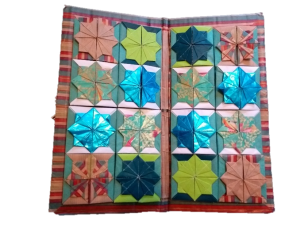
The maths booklet
Finally the design of the top layer gives many opportunities for discussing different patterns and symmetries, both of the overall design and of the individual boxes. Many of the original Zhen Xian Bao use ‘twist boxes’’ and are decorated with elaborate patterns, drawn or painted by hand or by using wooden stamps. However another option now is to design your own patterns for the boxes, using a computer drawing package.
Once the maths booklet was made, it just remained to fill the boxes with mathematical ideas and puzzles that might be suitable for a range of ages and mathematical abilities, ready for New Scientist Live. The ideas ranged from simple counting puzzles to unsolved problems such as the Collatz conjecture.
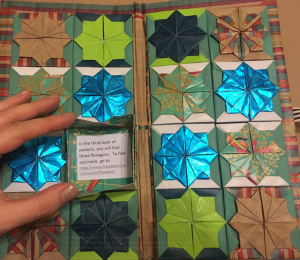
Hidden mathematics
The Zhen Xian Bao’s 31 boxes were filled with a range of puzzles and ideas, including:
- traditional puzzles such as hexaflexagons and matchstick puzzles
- tangrams, letter and area puzzles
- exploring the mathematical rules for origami crease patterns
- practical applications of origami.
Our mathematically filled Zhen Xian Bao was very popular with both adults and children alike at our OU STEM stand at NS Live. Many were fascinated by the hidden hexaflexagons and matchstick puzzles, others were struck by the patterns found within the different layers of boxes themselves.
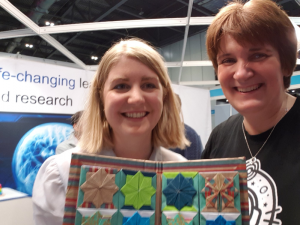
Here is OU lecturer Charlotte Webb (@WebbMaths) with visitor and Zhen Xian Bao enthusiast, Dawn Denyer (@mrsdenyer) at our STEM stand at New Scientist Live.
Reference:
Smith, R. and Corrigan, G., (2012) A little Known Chinese Folk Art: Zhen Xian Bao, Occidor Ltd.
